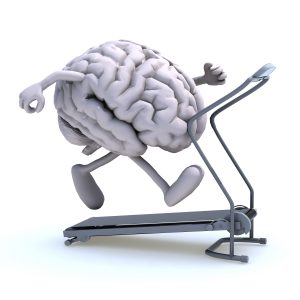 Brain training, a new(ish) kind of exercise.
Brain training, a new(ish) kind of exercise.
“Exercise” – exerting our muscles, sustaining an elevated heart rate and sweating, is essential to brain health, but training our brain with exercises designed specifically for brain fitness is a less familiar component of a brain healthy lifestyle. Many studies have examined the effects of brain training on neuroplasticity and improvements in cognitive function. Gains have been made not just by healthy adults but also by people with TBI (traumatic brain injury) and mild cognitive impairment (precursor of dementia & neurodegenerative disease).
How does brain training work?
There are several companies that offer brain training programs and sadly, I am not affiliated with any of them! All brain training exercises have a “game-like” aspect but they are not the same as video games nor do video games offer the same benefits (sorry guys!)
I enjoy brain training – it’s a great little diversion from my work! I particularly enjoy training after a cup of coffee and after different types of exercise (aerobic, strength training and yoga) because it’s interesting to see how those things impact my performance. My scores are consistently the highest after yoga – which is fascinating so I HAD to share!
Last month I became certified in the Bredesen Protocol by attending a conference at the Buck Institute for Aging in Novato, CA. While there I attended a brain training presentation by Posit Science, the creators of BrainHQ. Significant among their achievements is their participation in the ACTIVE study, a longitudinal study funded by the NIH, examining the effects of brain training on healthy older adults. One interesting finding from the ACTIVE study is that when you increase your processing speed you see improvements across all brain areas. To read more about the ACTIVE study click HERE:
Bottom Line: There are a few different companies offering brain training exercises on a subscription basis. Lumosity, which advertises heavily on public radio is one such company. I enjoy their brain training games and have been training with them for a few years. BrainHQ however, has a lot of science behind it so if you’re just starting out I would check them out first. Of course there’s no law that you can’t subscribe to more than one (pick me!)
A healthy brain still requires sound nutrition, exercise (the sweaty kind), good quality & quantity of sleep, and stress management to name a few. Then there’s joy and music and – – the list is long!
3 things to remember about brain training:
1. Brain training is not a “test”!
It’s designed to quickly assess where you are and adapt the exercises accordingly. It tracks your progress and keeps you challenged. In other words, you’re NEVER going to ace it!
2. Train for shorter time periods multiple times per week.
Posit Science recommends 20 – 40 minutes daily, 3 to 5 times weekly with a 40 minute max – after 40 minutes, performance degrades (and frustration increases!)
3. Don’t let the percentiles get you down!
Don’t get turned off if your percentile scores make you feel like you’re not the sharpest crayon in the box…after training consistently for a while you will notice gains and the gains are lasting.
In the ACTIVE study people only trained in years one and three yet improvements were measurable ten years out.
You may notice faster math computation when you’re out to dinner with friends or improvements in memory, focus and attention.
My name recall has improved and I have to give Lumosity props for that…they have a game in which you are wait person and you need to recall the (correctly spelled!) names of old “customers”.
It’s about the functional gain and not your percentiles (but those too, improve over time)!
To check out subscription costs or to try a free sample game visit:











Recent Comments